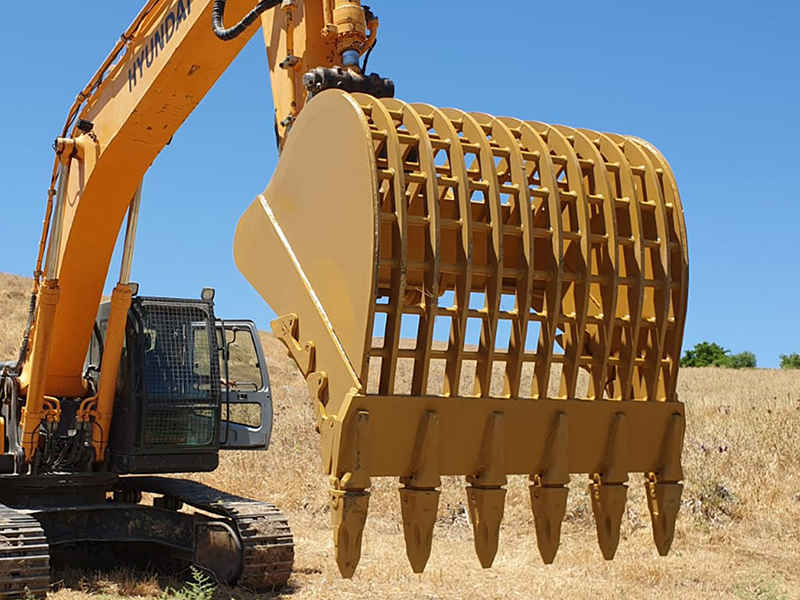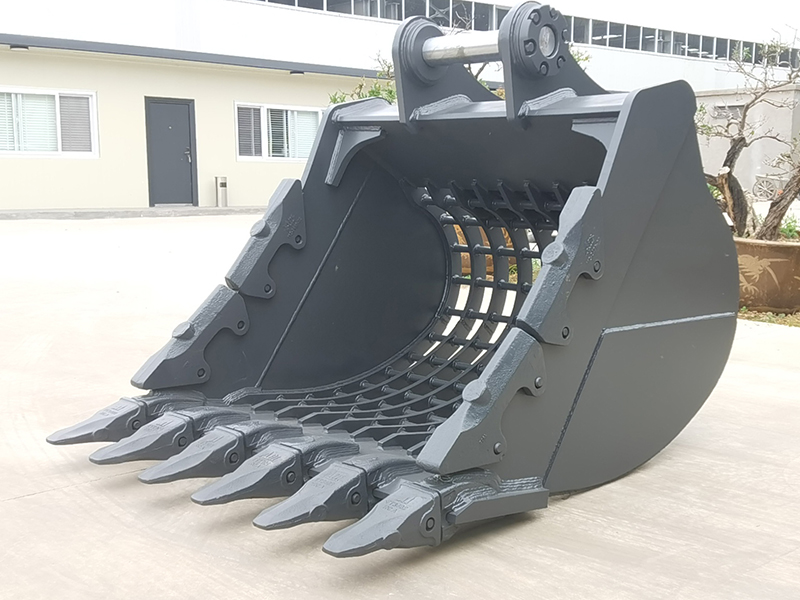The sieve bucket is an excavator attachment consisting of an open-top steel shell with a reinforced grid frame on the front and sides. Unlike a solid bucket, this skeletal grid design allows soil and particles to sift out while retaining large materials inside. Primarily used to remove and separate rocks and larger debris from soil and sand.
Structurally, the base and back of the bucket is made of steel plates welded together to form a hollow shell. According to different machine ton class and the different construction demand, the rear shell parts are welded by metal rods and steel plates into an open lattice grid ranging from 2 to 6 inches between openings. Some skeleton buckets designs have a side grid for enhanced sifting.
Manufacturing:
- Buckets are fabricated from high strength steel plate. This provides durability.
- Wear resistant steel plate can be used for high abrasion areas.
- Grid frames of the bucket rear shell parts are manually welded for maximum strength. A grid frames shell-plate by steel cutting are not recommended.
- Hardened steel rods have a minimum yield strength of 75ksi or 500MPa for grid construction.


The sieve bucket attaches to the boom stick via pivot joints and links just like a conventional bucket. The open grid framework provides the unique sifting functionality. As the bucket penetrates a soil pile or trench, surrounding dirt and particles are able to pass through the grids while rocks, roots, debris and other objects cascade over the grids into the bucket. The operator can control the bucket's curl and angle during digging to agitate the material and enhance sifting. Closing the bucket retains collected materials inside while opening it allows the filtered soil to sift out before dumping.
Sieve buckets are available in a range of sizes based on excavator model and capacity needs. Smaller buckets with 0.5 cubic yard capacity are suited for compact excavators while large 2 cubic yard models attach to 80,000lbs excavators used on heavy duty projects. The spacing between grid openings determines sifting performance. Grid openings are available in different spacing. Narrow spacing of 2 to 3 inches is optimal for sifting soil and sand. Wider 4 to 6 inches gaps allow rocks up to 6 inches to pass through.
In terms of functionality, the open grid framework enables a variety of sifting and sorting applications:
- Excavating and loading gravel, sand or aggregates while automatically removing oversize objects.
- Separating topsoil from subsoil by filtering rocks and debris from excavated layers.
- Selectively digging up roots, stumps and embedded rocks when excavating vegetated areas.
- Sorting demolition rubble and material piles by sifting out dirt, concrete fines, etc.
- Loading sorted materials into trucks since oversize objects and dirt have been removed.
In summary, the sieve bucket's skeletal grid construction allows it to efficiently scoop and separate soils from debris, rocks, roots and other unwanted materials. Careful selection of bucket size and grid spacing helps match performance to the excavator model and intended sifting applications. With its unique structure and functionality, the versatile sieve bucket improves productivity on all types of earthmoving and excavation projects.
Post time: Oct-10-2023
